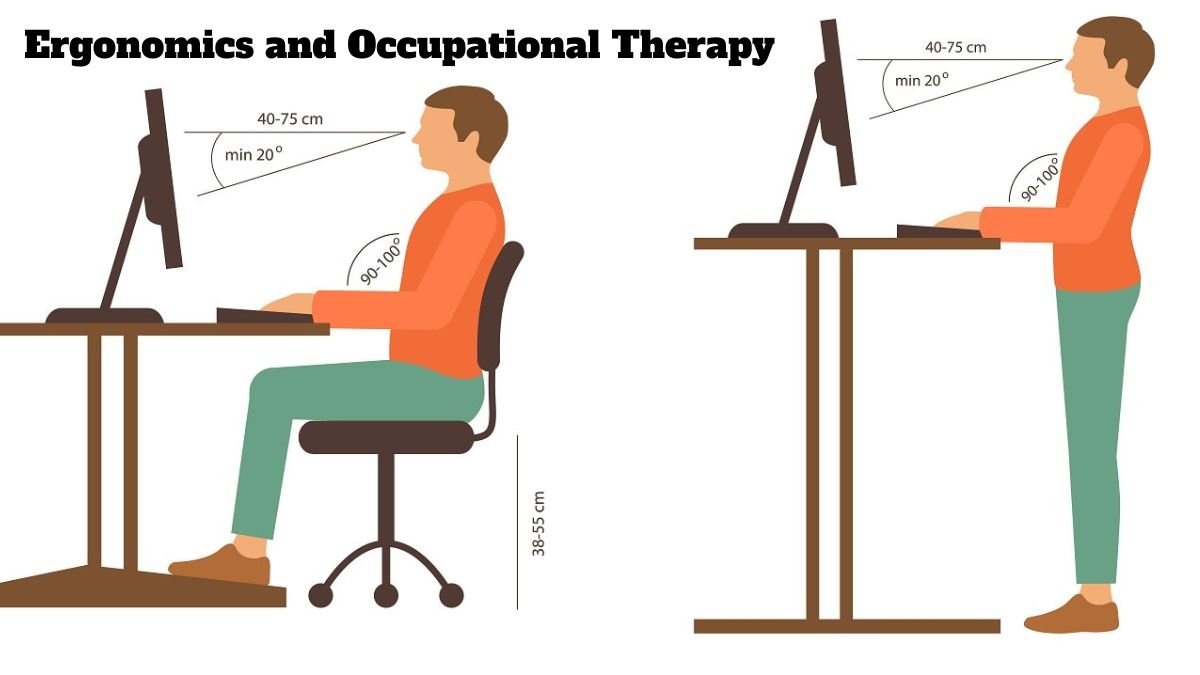In today’s world, when the pace of work is accelerating and lifestyles are changing, the most pressing question is how to maintain a balance between our physical and mental health. Sitting for long periods of time, hunching over a computer screen, or lifting heavy objects all directly impact our bones, muscles, and mental health.
The solutions to these problems are ergonomics and occupational therapy.
Both aim to increase human performance, reduce injury and stress, and improve quality of life.
Let’s explore them in detail –
What is ergonomics?
Ergonomics means designing work and workplaces in a way that is conducive to the body and mind.
For example:
- Office chairs should provide lumbar support.
- Computer screens should be at eye level.
- Table heights should be consistent with the body’s natural posture.
The main goals of ergonomics are:
- Injury Prevention
- Work Efficiency
- Correct Body Posture
- Reduced Fatigue
What is Occupational Therapy?
Occupational therapy is a method of therapy that helps people regain or improve their ability to perform everyday tasks.
This is especially important for people who:
- Are recovering from an injury
- Are undergoing rehabilitation after an accident
- Are experiencing a physical disability
- Are experiencing stress/anxiety
An occupational therapist’s job is to:
- Evaluate the patient’s working style
- Recommend appropriate equipment, techniques, and strategies
- Make daily activities easier
The Interrelationship Between Ergonomics and Occupational Therapy
Both have the same goal: to help people work and live better.
While ergonomics adapts the workplace to the individual, occupational therapy enables the individual to perform their work.
Example:
If an employee has persistent back pain, ergonomics will design the right chair and table for them.
The occupational therapist will teach them proper sitting, standing, and stretching exercises.
The Importance of Ergonomics in the Workplace
These days, companies and institutions pay special attention to ergonomics because:
- Employee productivity increases.
- Sick leave decreases.
- Stress and injuries decrease.
- Some important measures:
- A comfortable office chair
- A table at the right height
- A mouse and keyboard that supports the hands and wrists
- Maintaining a proper distance from the screen
- Taking short breaks during work
How does occupational therapy improve quality of life?
Occupational therapy helps people not only physically but also mentally.
- It makes them independent.
- It restores the ability to perform daily tasks.
- Boosts confidence.
- Improves mental health.
Example:
If a person has a broken arm and is unable to write or eat, an occupational therapist will make these tasks easier through new methods and equipment.
Ergonomics + Occupational Therapy = Best Results
- When the two combine, the effect is doubled.
- Optimizing the workplace (Ergonomics)
- Increasing a person’s work capacity (Occupational Therapy)
The combination of the two is especially useful:
For office workers
- For factory workers
- For the elderly and disabled
- For patients after an injury or accident
Common Problems and Their Solutions
- Back and neck pain – Adopting the correct chair and sitting posture.
- Wrist pain (Carpal Tunnel Syndrome) – Ergonomic keyboards and stretching exercises.
- Eye fatigue – Maintaining a proper distance from the screen and the 20-20-20 rule (looking 20 feet away for 20 seconds every 20 minutes).
- Mental stress – Relaxation techniques and breaks through occupational therapy.
Ergonomics and Occupational Therapy in the Indian Context
In India, companies and hospitals are gradually paying attention to this area.
- IT companies are providing ergonomic chairs and standing desks.
- The demand for occupational therapists is increasing in hospitals.
- Educational institutions are also emphasizing children’s posture and health.
Future Direction
- As work practices change in the future, the need for ergonomics and occupational therapy will increase.
- Work related to artificial intelligence and robotics will also require adapting to the body.
- In a hybrid work (home + office) culture, proper furniture and attention to health will be essential.
- Occupational therapy will also play an important role in promoting mental health.
Conclusion
Ergonomics and occupational therapy are not just processes for improving health, but also for enhancing the quality of life.
While ergonomics protects us from injury and fatigue, occupational therapy enables us to function in all conditions.
If we incorporate both into our workplace, lifestyle, and health, our lives and work will undoubtedly become more comfortable, safe, and successful.
